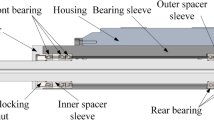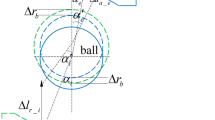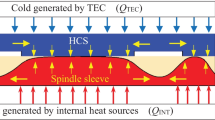Abstract
Forced cooling, as an efficient way of heat dissipation, significantly affects the spindle temperature. Although a full cooling passage was factored into the finite element analyses by some scholars, often only the model for the front/rear of a spindle is need for the purpose of the thermal evaluation simplification and data overhead reduction in engineering. For this, we devote to exploring how the coolant passage affects the heat dissipation of the front/rear halves of spindles by a constructed scaling factor, and accordingly create a simpler thermal evaluation model of spindles. Firstly, the experiments about a coolant unit effect on the thermal performance of spindles were first implemented, and thus, the temperature difference was noticed under various coolant parameter settings. Through the regressive analysis on the test data, the peak temperature area along axial direction was found and then the scaling factor was proposed to describe the effect of a cooling system on the temperature field of the front/rear half spindle. A similar structural coefficient, meanwhile, was also set up to state clearly the role of motor armature heating in the spindle temperature rise. Next, the thermal equivalent convection for a coolant passage was modeled based on the thermal resistance theory. Based on the abovementioned work, we planned a novel thermal network for only the front half of a motored spindle, in which the cooling mechanism was integrated, and the structural constraints were considered by the aid of the proposed scaling factors. Finally, the simplification and solution for this developed thermal grid were done, and the corresponding numerical results were compared with the test values. At the same time, the bearing heating with no or only 50% of a coolant unit, for the sake of better contrast and validation, was also simulated. The comparison results are indicative of a better agreement with real values when the proposed scaling factors are employed to considering the cooling unit impact on the high-speed motorized spindle temperature.











Similar content being viewed by others
Availability of data and material
Data are available.
References
Jiang SY, Lin SY (2021) Dynamic support stiffness of motorized spindle bearings under high-speed rotation. Int J Adv Manuf Technol. https://link.springer.com/article/10.1007/s00170-021-07282-1
Jiang SY, Lin SY (2018) A technical note: an ultra-high-speed motorized spindle for internal grinding of small-deep hole. Int J Adv Manuf Technol 97:1457–1463
Peterson W, Russell T, Sadeghi F et al (2020) A CFD investigation of lubricant flow in deep groove ball bearings. Tribol Int. https://doi.org/10.1016/j.triboint.2020.106735
Liu JL, Ma C, Wang SL et al (2019) Thermal-structure interaction characteristics of a high- speed spindle-bearing system. Int J Mach Tool Manu 137:509–514
Cao HG, Niu LK, Xi ST et al (2018) Mechanical model development of rolling bearing-rotor systems: a review. Mech Syst Signal Pr 102:37–58
Oktaviana L, Van-Canh T, Hong SW (2019) Skidding analysis of angular contact ball bearing subjected to radial load and angular misalignment. J Mech Sci Technol 33:837–845
Yan ZZ, Tao T, Hou RS et al (2020) A new modeling method for thermal errors of motorized spindle based on the variation characteristics of spindle temperature field. Int J Adv Manuf Technol 110:989–1000
Niel D, Changenet C, Ville F (2019) Thermomechanical study of high speed rolling element bearing: a simplified approach. P I Mech Eng J-J Eng 233:541–552
Li BJ, Cao HJ, Liu H et al (2019) Exergy efficiency optimization model of motorized spindle system for high-speed dry hobbing. Int J Adv Manuf Technol 104:2657–2668
Zhang P, Chen XA (2016) Thermal-mechanical coupling model-based dynamical properties analysis of a motorized spindle system. P I Mech Eng B-J Eng 230:732–743
Zhang LX, Li JP, Wu YH et al (2018) Prediction model and experimental validation for the thermal deformation of motorized spindle. Heat Mass Transfer 54:2691–2704
Meng Q, Yan X, Sun C et al (2020) Research on thermal resistance network modeling of motorized spindle based on the influence of various fractal parameters. Int Commun Heat Mass 117:1–14
Denkena B, Bergmann B, Klemme H (2020) Cooling of motor spindles—a review. Int J Adv Manuf Techol 110:3273–3294
Michael F, Markus H, Francois C et al (2012) Active outer ring cooling of high-loaded and high-speed ball bearings. J Eng Gas Turb Power. https://doi.org/10.1115/GT2012-68138
Sun YL, Zhang SW (2020) Experimental and numerical investigation on a novel heat pipe based cooling strategy for permanent magnet synchronous motors. Appl Therm Eng 170:114970
He Q, Shen Y, Ren FZ et al (2017) Numerical simulation and experimental study of the air-cooled motorized spindle. P I Mech Eng C-J Mec 31:2357–2369
Biesack WL, Loomis DW (1971) Electric high-speed spindle with cooling means, U.S. Patent, No. 3567975
Narashino SA, Kaisha SSK (1979) Lubricating and cooling system for spindle bearing assembly: U.S. Patent, No. 4137997
Xia CH, Fu JH, Lai JT et al (2015) Conjugate heat transfer in fractal tree-like channels network heat sink for high-speed motorized spindle cooling. Appl Therm Eng 90:1032–1042
Kang Y, Shi X, Gao J et al (2017) Thermal behavior analysis of a motorized spindle with novel shaft core cooling. J Xian Jiaotong Univ 51:13–18
Liu T, Zhou L, Gao WG (2021) Thermal simulation speculation-based active coolant control onto spindle bearings. Int J Adv Manuf Technol 113:337–350
Zhang YF, Wang P, Wg G et al (2018) Active and intelligent control onto thermal behaviors of a motorized spindle unit. Int J Adv Manuf Technol 98:3133–3146
Grama SN, Mathur A, Badhe AN (2018) A model-based cooling strategy for motorized spindle to reduce thermal errors. Int J Mach Tool Manu 132:3–16
Mori K, Bergmann B, Kono D et al (2019) Energy efficiency improvement of machine tool spindle cooling system with on–off control. CIRP J Manuf Sci Tec 25:14–21
Chien CH, Jang JY (2018) 3-D numerical and experimental analysis of a built-in motorized high-speed spindle with helical water cooling channel. Appl Therm Eng 28:2327–2336
Zhu K, Shi XJ, Gao JM et al (2018) Thermal characteristics analysis for motorized spindle with shaft core cooling based on numerical simulation and experimental research. J Xian Jiaotong Univ 52:40–47
Yan K, Hong J, Zhang JH et al (2016) Thermal-deformation coupling in thermal network for transient analysis of spindle-bearing system. Int J Therm Sci 104:1–12
Zhou CJ, Qu ZF, Hu B et al (2021) Thermal network model and experimental validation for a motorized spindle including thermal-mechanical coupling effect. Int J Adv Manuf Technol 115:487–501
Zheng DX, Chen WF (2020) Effect of structure and assembly constraints on temperature of high-speed angular contact ball bearings with thermal network method. Mech Syst Signal Pr 145:1–18
Zheng DX, Chen WF, Li MM (2018) An optimized thermal network model to estimate thermal performances on a pair of angular contact ball bearings under oil-air lubrication. Appl Therm Eng 131:328–339
Muzychka Y, Yovanovitch M (2001) Thermal resistance of model for non circular moving heat sources on a half space. J Heat Transfer 123:624–632
Xu M, Shuyun J, Ying C (2007) An improved thermal model for machine tool bearings. Int J Mach Tool Manu 47:53–62
Holman JP (1989) Heat transfer, 7th edn. McGraw-Hill, New York
Bjorklund IS, Kays WM (1959) Heat transfer between concentric rotating cylinders. Trans ASME 81:175–186
Wagner C (1948) Heat transfer from a rotating disk in ambient air. J Appl Phys 19:837–839
Cobb EC, Saunders OA (1956) Heat transfer from a rotating disk Proc R Soc 236:343–351
Churchill SW, Chu HHS (1975) Correlation equations for laminar and turbulent free convection from a vertical plate. Int J Heat Mass Tran 18:1323–1329
Churchill SW, Chu HHS (1975) Correlation equations for laminar and turbulent free convection from a horizontal cylinder. Int J Heat Mass Tran 18:1049–1053
Li XT (2016) Calculation and design of heat exchange for motor operation. Zhejiang University Press, Hangzhou
Palmgren A (2009) Ball and roller bearing engineering, 3rd edn. Burbank Philadelphia, USA
Latif MJ (2009) Heat convection, 2nd edn. Springer-Verlag, Berlin
Dittus FW, Boelter LMK (1930) Heat transfer in automobile radiators of the tubular type. Univ Calif Pubs Eng 2:443–461
Funding
This work was funded by the Natural Science Foundation of Jiangxi Province, China (no. 20212BAB204033), the National Natural Science Foundation of China (no. 51775277), and the National Science and Technology Major Project of the Ministry of Science and Technology of China (no. 2015ZX0401002).
Author information
Authors and Affiliations
Contributions
Zheng De-xing is the main contributor to this paper. He implemented the experimental studies and next proposed the structural scaling factor to describe the role of a coolant unit in spindle temperature. This factor was also integrated into the developed thermal grid model for the front half of motorized spindle. Meanwhile, he validated the proposed structural scaling factor by comparing the simulation with test results. Chen Weifang gave some valuable comments in improving the technical route of this work.
Corresponding author
Ethics declarations
Consent to participate
All authors consent to participate in the author team of this submitted manuscript.
Consent to publish
The submitted manuscript is approved by all authors for publication.
Conflict of interest
The authors declare no competing interests.
Additional information
Publisher's note
Springer Nature remains neutral with regard to jurisdictional claims in published maps and institutional affiliations.
Rights and permissions
About this article
Cite this article
De-xing, Z., Weifang, C. Effect of a cooling unit on high-speed motorized spindle temperature with a scaling factor. Int J Adv Manuf Technol 120, 2559–2572 (2022). https://doi.org/10.1007/s00170-022-08958-y
Received:
Accepted:
Published:
Issue Date:
DOI: https://doi.org/10.1007/s00170-022-08958-y




